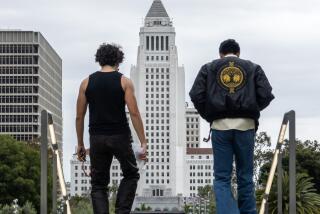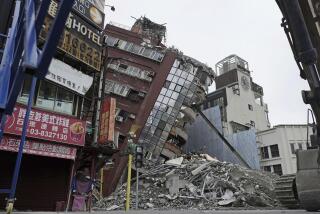In New Zealand, a centerpiece becomes a tomb
Reporting from Christchurch, New Zealand â Veteran television producer Rob Cope-Williams was out in the field Tuesday, working on his weekly farm report, downing a lunch of French fries and a pint of beer at a countryside hotel, when he felt the jolt.
He and his crew figured it was just another harmless aftershock from an earthquake that had struck this Victorian-style tourist mecca five months ago.
âI said: âThereâs another one. Iâll bet the [blokes] back at CTV didnât even feel it,â â Williams recalled.
But they did. At 12:51 p.m., as the ground beneath Christchurch shook violently, numerous downtown structures collapsed, including the one that housed Williamsâ home office.
The five-story Canterbury Television building on Madras Street, a city centerpiece for more than four decades, shuddered, teetered and then crumbled down on itself. Within seconds, the building that housed a local TV station, a medical clinic and an English-language school that drew students from around the world became a tomb.
Yet nobody knew that just then. Over the course of the next 36 hours, the CTV building â along with a handful of other urban towers â became the scene of miraculous rescues; scores of people were pulled Houdini-like from the wreckage, calling for help in 10 different languages.
There was an injured woman who tapped on concrete to hasten help, the Christchurch resident who called her children on her cellphone to say goodbye, and the foreign student who texted her father in China to tell him she was trapped underneath rubble â all rescued.
But then the miracles ceased; the cellphones went silent. Two days after the quake struck, Christchurch officials said the CTV building would yield up no more life.
âUnsurvivable,â was the word they used for the destruction there.
For tiny New Zealand, an isolated nation of just 4.4 million residents, the earthquakeâs statistics are heartbreaking. By Saturday, 145 people had been confirmed dead and more than 200 others listed as âmissing and in concern.â More than half of the missing â an estimated 120 â were believed to be buried under the still-smoking remains of the building on Madras Street.
Among those presumed dead are Murray Wood, the managing director of Canterbury Television, the father of six children â five sons and a daughter â and Rhea Mae Sumalpong, 25, one of nine Filipino nurses believed to be in the ruins.
There is also Maysoon Abbas, a Baghdad-trained family doctor who came to New Zealand 15 years ago. She was seeing patients on the fourth-floor clinic when the quake struck, âhelping people to the last moment of her life,â her daughter said.
And there is TV producer Donna Manning, whose husband and two children suffered another blow after the one that nature delivered: While they sat outside the CTV building, awaiting word on her fate, burglars invaded their home, taking much of Manningâs jewelry.
Then there are the estimated 40 foreign students at the Kingâs Education language school, including a dozen from Japan; the Japanese government sent a specially trained search-and-rescue team that has concentrated on the CTV building.
Many were from a language school in the city of Toyama, a two-hour bullet-train ride out of Tokyo. A Japanese reporter assigned to cover the earthquakeâs aftermath said the entire nation was awaiting word of the unaccounted-for studentsâ fates.
âIn Japan, earthquakes happen a lot and people know the terror,â said camerawoman Akiko Yuasa. âAnd for these students, it was just so unlucky. So many of them were in one building â and they were here for just two weeks. And then this happens.â
Christchurch officials are grim about the immediate future of their beloved city, where the statue of founder John Robert Godley sprawls, broken in pieces, at the base of its plinth in a central square, a cerebral wound inflicted by the temblor now known here as the Canterbury quake.
Rebuilding costs are estimated at $10 billion, and engineers say one-third of the buildings in the central business district â most made from brick â will be demolished. Among them is the 27-story Hotel Grand Chancellor, which teeters at an odd angle, seemingly ready to fall. Over the weekend, searchers entered the building for the first time since the quake to recover bodies.
There are other tragic sites here, such as the downtown Pyne Gould Guinness building where multiple bodies were recovered. And the iconic Christchurch Cathedral, where numerous people died when the spire collapsed, raining brick and mortar atop noon-hour visitors.
But the CTV building remains the most significant in its death toll; each day searchers pull more bodies from the wreckage.
A first-floor receptionist told reporters that the noise was the first thing that struck her â the shattering glass and sucking of the wind.
Colleagues had teased her for running for the door during aftershocks of the Sept. 4 quake. Still, she took no chances, running for the light outside. âI was sure that something was going to hit me,â she said, âthat I wouldnât make it.â
A government counselor on the buildingâs top floor was consulting with a patient still in shock from the last quake. She made it out of the building with three broken limbs and a collapsed lung. The fate of the patient is unknown.
TV producer Cope-Williams remains sleepless over the loss of a dozen colleagues and the building he reported to for 21 years.
âI can still see their faces and hear their voices,â the 61-year-old said. âThey wonât go away. How can God be so selective?â
More to Read
Sign up for Essential California
The most important California stories and recommendations in your inbox every morning.
You may occasionally receive promotional content from the Los Angeles Times.











